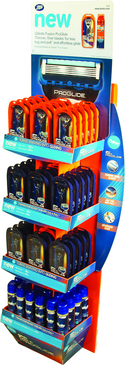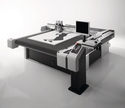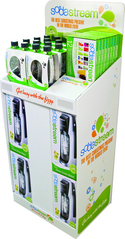Set up and sell fast
2 March 2011Point of sale and promotional displays serve as an extension of product and retailer branding. Their job is to beckon shoppers, sometimes to deter pilfering and always to fit into a shop’s overall design concept. Joanne Hunter reports.
Brands and retailers expect to enjoy the benefits of point of sale and purchase displays that are well designed to trigger shoppers to buy. Turnaround of promotions is getting faster and techniques being used to grab attention in a busy environment are becoming ever more sophisticated: how is the sector coping?
Print impact for promotional point of sale and displays relies on a few, highly regarded techniques, explains Dev Brahmachari, Sales & Marketing Director for CRP.
“At CRP we have in-house digital and the latest litho printed technology. The brands require perfect colour and consistency of imagery: there really is only litho print that allows faithful reproduction and consistency. The use of spot varnishes and high gloss UV varnishes are all well used. With a number of large promotional activities on the horizon, not least The London Olympics, brands will be keen to find the right imagery and graphics to engage with consumers.”
‘Set up and sell’ followed by ‘strike and go’ is the kind of speed and agility that is required in a functional product design. Says Mr Brahmachari: “CRP has been at the centre of clever, imaginative, functional design for the last 20 years. We have developed a range of instant erect, low cost units that can be merchandised in-store.
“Brand owners are constantly looking for interesting shapes and forms to engage with consumers. When launching new products it is vital to achieve ‘standout’. This is done by both the structural design and the use of graphics. CRPs in-house studio team provides support to customers in recommending layouts and use of design.”
Displays ready filled with product are labour saving in-store, and keep brand owners in control. “This is a growth area, with the brands choosing to have perfect execution in-store, relying on outside logistics companies to fill the displays prior to going into store. This allows them to ensure that promotional activity takes place and the execution is done in a timely way, fitting with other media.”
In-house resources have to cope with the ever-shortening lifespan of temporary fixtures. “Typically, temporary POS should be in-store for three months; however, most promotional periods are much shorter. As in all industries, lead times are reducing. Due to our investment programme in our own in-house printing and prepress technology, we are able to respond quickly, as we are not relying on outside suppliers.”
Quick turnaround of promotions calls for waste prevention strategies. “Here, the key issue is that temporary display units tend to be manufactured from corrugated fibreboard and other paper-based products: all come from sustainable sources. Where possible, we would always design using paper-based materials. At CRP we are working towards FSC and PEFC accreditation within our Display business later this year. This will give is a chain of custody demonstrating to brand owners that we are able to trace the core materials used in the display back to sustainable sources.”
Brands are keen to achieve a homogeneous appearance from primary pack to POS products. The challenge can be overcome by using a single source of supply.
“At CRP we are often chosen to link the shelf-ready packaging with the display product. We are able to design and print both the display units and SRPs using the same process giving the brand owner perfect replication.”
Retail ‘theatre’
Where do shoppers look first in a store and how does this impact the development of successful secondary placement at the POS?
For the STI Group, eye tracking provides the answer. Part of POPAI (Point of Purchase Advertising International), STI says: “It allows us to see the (retail) world through shoppers’ eyes in the truest sense of the word.
“With the use of eye tracking we want to provide our customers with shopper insights and how such insights translate into the design of sales promotion tools,” explains Norman Thom, General Manager of STI POS Solutions. The company is also promoting a new thin, lightweight multilayer film: El Sign. It converts electrical energy into light without generating heat. The advertising messages illuminated and animated in such a way are said to have a strong impact on shoppers’ impulse buying. Printing can be 4-colour and the film formats range from label to billboard size. El Sign was developed with Synergetic Media, a strategic partner with branch offices in the USA, Canada and China.
“An attention-grabbing look is needed to prompt shoppers to buy,” says Prof Dr Frank Ohle, Chairman of the Board at STI Group.
STI claims that in the USA, retail sales were up almost 90% thanks to the use of El Signs on displays, against a 39% sales increase when using static, conventional displays. The same study concluded that store managers tend to place 88% of illuminated and moving displays in the principal promotion zones of the store, while half the conventional displays are placed in less attractive POS locations.
In contrast, Dev Brahmachari is of the opinion that supermarket chains in the UK and Europe, where CRP’s business comes from, are less theatrically minded than retailers ‘across the pond’, and the cost is off-putting. “Supermarkets limit the use of in-store ‘theatre’, trying instead to create a consistent image in-store. CRP is constantly working with all the major retailers to ensure that we are abreast of changes in compliance.”
He concedes: “To create standout some brand owners will use lighting and sound, however these are still relatively limited due to cost and the scalability.”
Theft prevention
Inventory shortfalls develop in the retail industry every day, every year. Millions of products are lost as a result of shoplifting by customers and employees. In Germany, POS Tuning offers the successful solution for all high-theft products. An optimal product presentation and effective theft prevention are combined into a unit called ‘T-Save Presentation’, which is claimed to reduce inventory shortfall by up to 90%.
The POS system is designed to ensure a clear arrangement of the product presentation of all goods; easy handling for the customer and staff; and safe theft prevention for self-service retail environments that use modern techniques.
A contact situated within the fixture raises an alarm when the door is opened or tampered with. An automatic sound such as a greeting or promotional message is activated, for instance. And it may state the legal age for purchasing tobacco products.
The potential thief has to use both hands to open the gate to get to the product, acting as an obstacle to product removal. If the product is not removed within a 10sec time window a verbal message will be activated inviting you to close the gate.
To end the raid, if the request to close the gate is not observed, an alarm signal will sound. The alarm signal will cease if the gate is closed.
Make it easy
The end POS product is only as good as the finishing. To make it easier to achieve high quality, creative POS, the wide format flatbed cutter and router manufacturer Zünd UK is offering a design system called Packz. It is considered so versatile that users in the POS, POP and packaging segments can help themselves expand and diversify to grab new commercial opportunities.
According to Zünd, Packz helps novice and seasoned operators to design ‘stunning and unusual’ 3D packaging and displays quickly, easily and professionally. It offers a wide scope of drawing capabilities with automated assistance and tools. Compatible with Windows 7, 2000, XP and Vista, there are more than 80 POS display templates and a selection of standard corrugated designs and standard folding cartonboard or polymer designs.
For sophisticated displays, it is possible to create ‘realistic’ 3D visuals with lights, reflections and shadows, and to animate it or create an AVI movie.
John E Wright, based in the Midlands, has been using a Zünd flatbed cutter for three years and its Technical Director Alan Edwards says: “Put simply, if we need to cut anything through our print house, it goes through the Zünd. It cuts a massive amount of different substrates, including plastics, corrugated, display board, die bond and, of course, paper. It’s completely reliable and in use almost 24 hours a day.
“The Zünd allows us to create complicated shapes to exacting standards.” For example, it allowed John E Wright to produce life-size cut-outs of policemen that were rolled out across retail outlets in the Midlands area.
Displaypak in the UK speeded up its production of creative displays by using a packaging design software system called KaseMake.
With PDF export, ‘in true 3D’, it is possible to email the proposal for the client to look at, fully rendered with graphics, from any angle.
“We can propose multiple designs to our clients at the click of a button,” says Displaypak’s Managing Director, Andy Dearman. “We have entered into dialogue with the client and perhaps shown them several modifications before our competitors have delivered even the first sample.”
The machine is being used for short production runs as well as prototyping.
“The ability to produce a production run without the delays and costs involved with diecutting or finishing by hand, has opened up new markets to us. We see the KaseMake system as the final loop in our workflow, allowing us to keep the creative knowledge in-house.”
CRP 1 CRP has been producing imaginative and functional designs for 20 years. CRP 2 Zünd’s Packz system makes ‘stunning and unusual’ 3D packaging and displays easier to design. Zund Display pack made using the Packz system. Packz





